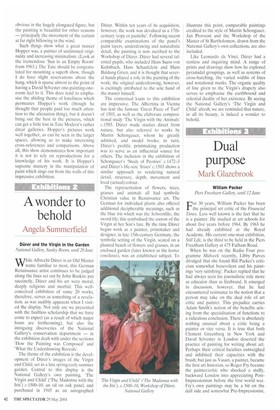A wonder to behold
Angela Summerfield
Diirer and the Virgin in the Garden .\",//i(»wl Gallery, Sunley Room, until 20 June While Albrecht Darer is an Old Master name familiar to most, this German Renaissance artist continues to be judged along the lines set out by John Ruskin: put succinctly, Durer and his art were moral, deeply religious and morbid. This wellconceived exhibition of some 20 works, therefore, serves as something of a revelation, as was audibly apparent when I visited the display. Not only are we presented with the faultless scholarship that we have come to expect (as a result of which major loans are forthcoming), but also the intriguing discoveries of the National Gallery's conservation department — in the exhibition dealt with under the sections 'How the Painting was Composed' and 'What the Underdrawing Reveals'.
The theme of the exhibition is the development of Diirer's images of the Virgin and Child, set in a late spring/early summer garden. Central to this display is the National Gallery's own painting, 'The Virgin and Child' (`The Madonna with the Iris') c_1500-10, an oil on oak panel, and purchased in 1945 as an autographed
I Diirer. Within ten years of its acquisition, however, the work was devalued as a 17thcentury 'copy or pastiche'. Following recent comparable examinations of the panel's paint layers, underdrawing and naturalistic detail, the painting is now ascribed to the Workshop of Darer. DiIrer had several talented pupils, who included Hans Suess von Kulmbach, Hans Schaufelein and Hans Baldung Grien, and it is thought that several hands played a role in the painting of the work; the original underdrawing, however, is excitingly attributed to the sole hand of the master himself.
The contextual loans to this exhibition are impressive. The Albertina in Vienna has lent the famous 'Great Piece of Turf of 1503, as well as the elaborate compositional study 'The Virgin with the Animals' c.1503. Diirer made studies direct from nature, but also referred to works by Martin Schongauer, whom he greatly admired, and model books; in turn, Diker's prolific printmaking production was to serve as an influential source for others. The inclusion in the exhibition of Schongauer's 'Study of Peonies' c.1472-3 and Dtirer's life-size 'Irises' c. 1503 shows a similar approach to rendering natural detail, structure, depth, movement and local (actual) colour.
The representation of flowers, trees, grasses and animals all had symbolic Christian value in Renaissance art. The German for individual plants also offered additional decipherable meanings, such as the blue iris which was the Schwertlilie, the sword lily; this symbolised the sorrow of the Virgin at her Son's fate. By the time Darer began work as a painter, printmaker and designer, in late 15th-century Germany, the symbolic setting of the Virgin, seated on a planted bench of flowers and grasses, in an enclosed garden (later known as the hortus conclusus), was an established subject. To illustrate this point, comparable paintings credited to the style of Martin Schongauer, Jan Provoost and the Workshop of the Master of St Bartholomew, drawn from the National Gallery's own collections, are also included.
Like Leonardo da Vinci, Diirer had a restless and inquiring mind. A range of prints and drawings show how he explored pyramidal groupings, as well as systems of cross-hatching, the varied widths of lines and notational marks. The organic quality of line given to the Virgin's drapery also serves to emphasise the earthbound and celestial duality of her existence. By seeing the National Gallery's 'The Virgin and Child' afresh, we are reminded that nature, in all its beauty, is indeed a wonder to behold.


































































 Previous page
Previous page